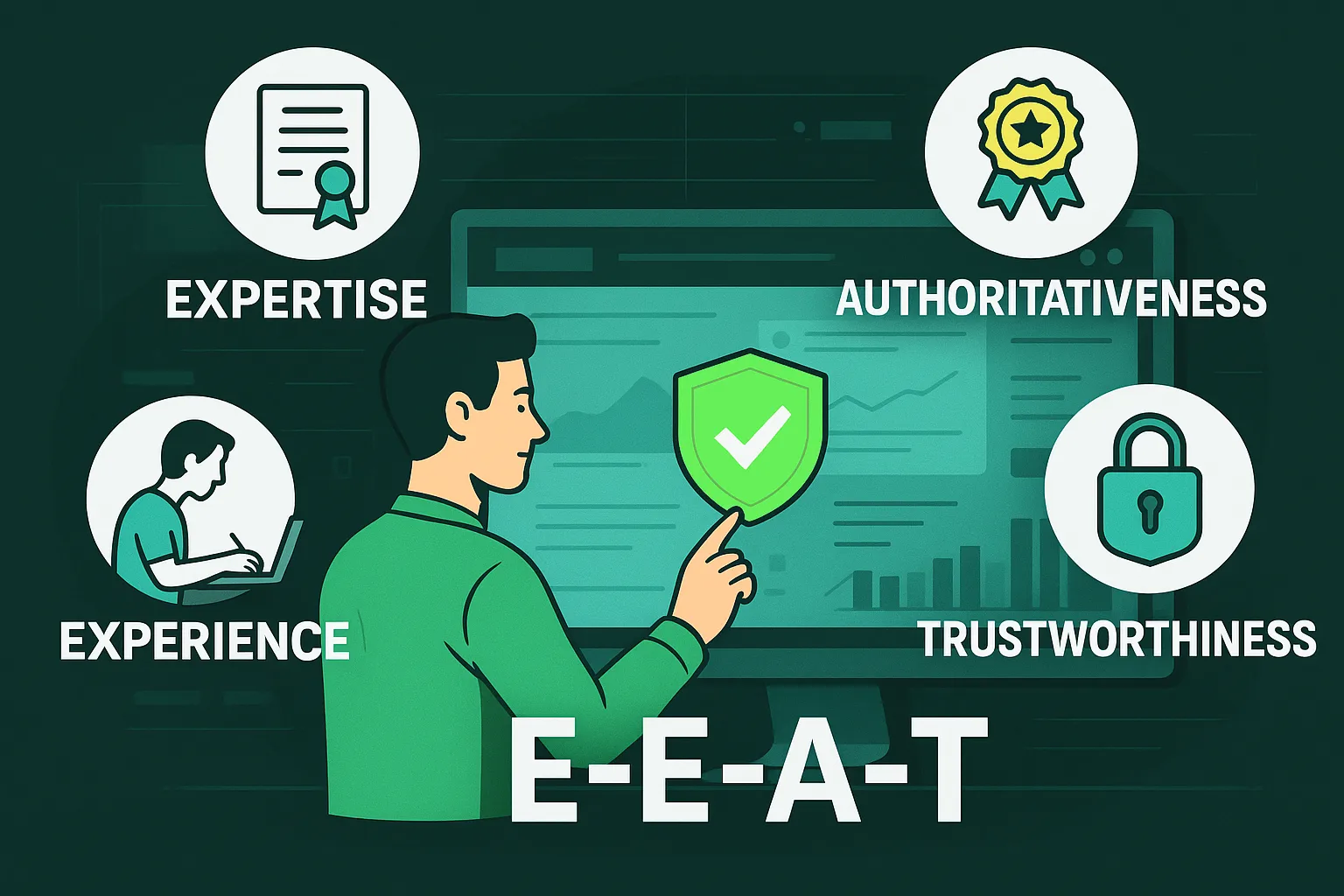Building a solid reputation and proving that you’re a reliable source of information in your field is what it’s all about. This is where Google’s concept of E-E-A-T comes into play — a fundamental pillar that determines the quality and trustworthiness of a website.
But what exactly is E-E-A-T, and how can you apply it to your business, whether you sell software, offer financial consulting services, run dental clinics, or have an online store?
In this ultimate guide, we’ll break down each component of E-E-A-T and offer practical strategies and real-life examples so that you can strengthen your brand authority and, as a result, improve your rankings on Google — no matter what your niche is.
What Does E-E-A-T Really Mean? A Breakdown
E-E-A-T is the acronym used by Google to assess content quality based on four pillars: Experience, Expertise, Authoritativeness, and Trustworthiness.
- Experience: This refers to hands-on, first-hand knowledge. Has the author genuinely used the product they’re reviewing? Has the travel blogger actually visited the places they write about? Google wants to see proof of real, lived experience.
- Expertise: This is about formal and professional knowledge on a subject. It’s especially important in YMYL (Your Money or Your Life) fields like health, finance, or law. Expertise is demonstrated through qualifications, training, and a recognised track record.
- Authoritativeness: Authority is built when other experts and influential websites in your industry recognise you as a reliable source. This shows through mentions, links from reputable sites, reviews, awards, and so on.
- Trustworthiness: Trust is the pillar that ties everything together. A trustworthy website is transparent, secure (HTTPS), honest, and puts the user first. Clear contact information, privacy policies, and easy return processes are all trust signals.
How to Implement E-E-A-T in Your Business (With Real Examples)
Applying E-E-A-T isn’t about ticking a few boxes — it’s a series of best practices that should be adapted to each industry. Here’s how:
1. To Demonstrate EXPERIENCE and EXPERTISE
Your aim is to make it clear that you know what you’re talking about — whether through your qualifications or hands-on experience.
- Create detailed author bios: Don’t just include a name. Explain who is behind each piece of content.
- Example – Physiotherapy Clinic: Each physiotherapist’s profile should include their degree, specialisations (e.g. sports, neurological), years of experience, and registration.
- Example – Speciality Coffee E-commerce: The “About Us” page should tell the founder’s story, their trips to coffee farms, their certification as a taster, and their passion for coffee.
- Publish case studies and real results: Social proof is your best ally.
- Example – Financial Consultancy: Publish a detailed (anonymous) article about how you helped a family plan their retirement, outlining the steps and strategy.
- Example – Car Repair Workshop: Write a blog post with before-and-after photos of a complex repair, explaining the technical process you followed.
- Show your credentials and certifications: Make them visible across your entire website.
- Example – Law Firm: Include seals from legal associations, legal awards, and certifications in specific fields.
- Example – Sports Supplements Store: Display quality seals, lab test certificates, and any approvals from health authorities.
2. To Build AUTHORITATIVENESS
Your goal is to be recognised as a leader in your industry.
- Earn quality links and mentions: Authority is transferred.
- Example – Tech Startup: Being mentioned in a specialist publication like Xataka or Wired is a huge signal of authority.
- Example – Local Restaurant: A positive review in the local paper, a strong social media presence, a well-regarded food guide or a blog written by a foodie builds local authority.
- Encourage reviews and testimonials: Let your customers speak for you.
- Example – Fashion E-commerce: Integrate review platforms like Trustpilot and display customer opinions (with product photos) prominently.
- Example – SaaS Company: Showcase the logos of companies you work with and include video testimonials from managers or key users.
3. To Generate TRUST
Trust is the foundation of any lasting business relationship.
- Be fully transparent: Be clear and direct.
- All Niches: Your “Contact” page should be easy to find and include a physical address (if applicable), a phone number, and an email address. For Google, a business that can be found in the real world is more trustworthy.
- Example – Health Blog: Include a clear disclaimer stating that the content is informational and not a replacement for professional medical advice.
- Clear and accessible policies: Don’t hide the fine print.
- Example – Online Store: Shipping, returns, and warranty policies should be easy to understand and available within one click. This reduces buying anxiety and builds trust.
- Security and sources: Protect your users and back up your content.
- All Niches: Your website must have an active SSL certificate (HTTPS). It’s a basic signal of security and trust for both users and Google.
- Example – Investment Blog: When providing data or advice, always link to original sources: market reports, economic studies, or reputable financial news websites.
What Should Be On Your Website’s Trust Checklist?
TECHNICAL SECURITY
- Website has an active SSL certificate (HTTPS).
- Login pages, forms, and payments are encrypted.
- No browser warnings or alerts about unsafe content.
- No invasive pop-ups, dodgy redirects or aggressive retention tactics.
CONTACT INFORMATION
- A visible contact page accessible from the menu or footer.
- A professional email address (not Gmail, Yahoo, etc.).
- A phone number and physical address, if applicable.
- Registered with Google Business Profile if it’s a local business.
CLEAR LEGAL POLICIES
- The site includes:
- Privacy policy
- Legal notice (with company details, if relevant)
- Cookie policy with banner and controls
- Terms and conditions
- All policies are up to date, clearly written and linked from the footer.
IF YOU RUN AN E-COMMERCE SITE
- Clear information on:
- Shipping policy
- Returns and refunds
- Guarantees
- Order tracking or support channels available.
- Secure payment methods (Visa, PayPal, Stripe, etc.).
TEAM AND BRAND TRANSPARENCY
- An “About Us” page with real information about the team or company.
- Team photos, real names, and professional links (e.g. LinkedIn).
- Display of certifications, awards, or accreditations where relevant.
REPUTATION AND CREDIBILITY
- Genuine customer reviews (not fake).
- Ratings integrated from verified platforms (Google, Trustpilot, etc.).
- Professional responses to negative feedback.
- Presence in media, blogs, or relevant professional circles.
What Are the Warning Signs of a Site That Lacks Trust?
- A suspicious domain or one that doesn’t match the business name.
- Excessive use of all caps, misleading phrases or aggressive CTAs.
- Over-the-top promises without proof (“Lose 10kg in 3 days”, “Guaranteed returns with no risk”).
- No author information or editorial context.
In Short: E-E-A-T Is Your Long-Term Business Strategy
As we’ve seen, optimising for E-E-A-T goes far beyond technical SEO. It’s a business philosophy that puts quality, transparency and customer experience at the centre of everything you do.
Whether you’re a local artisan, a B2B consultancy or a health clinic, building a brand that both users — and therefore Google — can trust is the most profitable and sustainable investment for your digital future.
Want to know how your website performs in terms of E-E-A-T? Contact us today and we’ll carry out an audit to highlight your strengths and opportunities to help you gain the trust of both your customers and Google.







